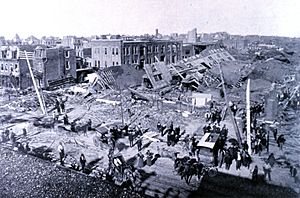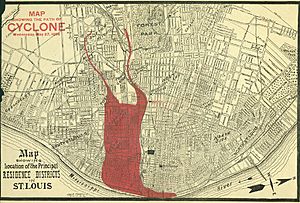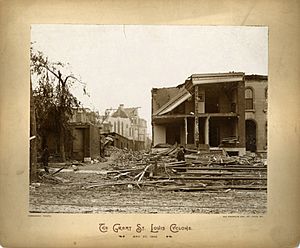1896 St. Louis–East St. Louis tornado facts for kids
| F4 tornado | |
|---|---|

Tornado damage, Union Depot, Jefferson and Allen Avenues, St. Louis, National Oceanic and Atmospheric Administration photograph by J. C. Strauss, May 27, 1896
|
|
| Type | Tornado outbreak |
| Duration | May 27–28, 1896 |
| Max rating1 | F4 tornado |
| Duration of tornado outbreak2 | Unknown |
| Damage | $10 million ($352 million in 2022) |
| Areas affected | St. Louis, Missouri metro area East St. Louis, Illinois |
| 1Most severe tornado damage; see Fujita scale 2Time from first tornado to last tornado | |
The 1896 St. Louis–East St. Louis tornado was a huge and powerful tornado. It caused a lot of damage in downtown St. Louis, Missouri, and East St. Louis, Illinois. This happened on Wednesday, May 27, 1896, around 5:00 PM.
This tornado was one of the deadliest and most destructive in U.S. history. It was part of a larger group of tornadoes that hit the central United States. The St. Louis tornado alone killed at least 255 people. Over a thousand more were hurt. It caused more than $10 million in damage, which is a lot of money even today. The tornado lasted for about 20 minutes. More than 5,000 people lost their homes and all their belongings. The areas hit hardest included Lafayette Square and Compton Heights. It is still the third-deadliest tornado in United States history.
Contents
The May 1896 Tornado Outbreak
| FU | F0 | F1 | F2 | F3 | F4 | F5 | Total |
|---|---|---|---|---|---|---|---|
| ? | ? | ? | 5 | 5 | 4 | 0 | 14 |
Weather experts had predicted a storm for late May. However, many people in St. Louis did not think their city would be affected. Back then, forecasters did not have the technology to predict tornadoes. They could only predict strong storms in general.
The day started calmly, with people doing their usual activities. The morning weather did not suggest any severe storm. The local weather office only predicted thunderstorms. Around noon, the clouds started to look more threatening. The air pressure also dropped, which was a sign of a tornado for those who knew.
As the afternoon went on, the sky grew darker. But the Weather Bureau Observatory was not too worried. Many residents, though, went home, expecting bad weather. At 4:30 PM, the temperature quickly dropped. Dark, greenish clouds moved toward the city. Near 5:00 PM, the sky reportedly became as dark as midnight.
As the thunderstorm reached St. Louis, the western part of the city was hit first. Winds started around 37 miles per hour (60 km/h). They quickly grew to almost 80 miles per hour (130 km/h).
The first major tornado of the day formed near Bellflower, Missouri. It killed one person. Three students died and 16 were hurt when the Dye School in Audrain County was hit. This happened around 6:15 PM. The same tornado killed one student and hurt 19 others at the Bean Creek school a few minutes later.
At 6:30 PM, two very strong thunderstorms created two more tornadoes. One destroyed farms in New Minden, Hoyleton, Richview, and Irvington, Illinois. Twenty-seven more people died in other Illinois tornadoes during this outbreak.
The St. Louis–East St. Louis Tornado
The tornado from the other supercell touched down in St. Louis, Missouri. At that time, St. Louis was one of the biggest cities in the country. This tornado was one of at least 18 tornadoes that day. It quickly became the third-deadliest and most expensive tornado in U.S. history.
At least 137 people died as the tornado moved through the city center. It left a continuous path of destruction about 1-mile-wide (1.6 km). Homes, schools, factories, churches, and train yards were destroyed. Some homes were almost completely swept away. Many trees were knocked down at the 36-acre (0.15 km2) Lafayette Park. A device there recorded a big drop in air pressure.
The tornado then crossed the Mississippi River. It hit the Eads Bridge. A wooden plank, 2 in × 10 in (51 mm × 254 mm), was found stuck through a thick iron plate. Many people on boats on the river might have also died.
The tornado continued into East St. Louis, Illinois. There, it was smaller but even more powerful. Homes and buildings along the river were completely swept away. A quarter of all buildings in East St. Louis were damaged or destroyed. Another 118 people were killed there. Thirty-five of them died at the Vandalia railroad freight yards.
By the end of the day, 255 deaths were confirmed. Some estimates said over 400 people died. More than 1,000 people were injured. This tornado was later rated F4 on the Fujita scale. This means it was very strong.
After the tornado, volunteer soldiers helped out. Within an hour, 32 soldiers were helping with rescue efforts. The mayor asked them to stay on patrol for several days. Bicycle messengers helped because telephone and telegraph wires were broken. Streets were also blocked.
The city was so damaged that some wondered if St. Louis could host the 1896 Republican National Convention. This big event was planned for June, just three weeks later. But after a huge cleanup effort, the convention happened as planned.
Long-Term Effects
The St. Louis tornado of May 27, 1896, was the most damaging known in the United States up to that time. About 12,000 buildings were badly damaged. The total cost was over $10 million.
News about the tornado spread everywhere. Over 140,000 people came to see the damaged areas. The tornado changed how homes, shops, and factories were built in the most damaged parts of the city. Areas not hit by the tornado were not affected in this way.
St. Louis Tornado History
It is unusual for a large city center to be directly hit by a tornado. This is because tornadoes are relatively small. Also, there are not many big cities in the areas where tornadoes happen most often. However, several other tornadoes have hit the City of St. Louis throughout its history. Some of these tornadoes were also very deadly and destructive.
Tornadoes have hit St. Louis in:
- 1871 (9 killed)
- 1890 (4 killed)
- 1904 (3 killed, 100 injured)
- 1927 (72-79+ killed, 550+ injured)
- 1959 (21 killed, 345 injured)
This makes St. Louis the urban area in the U.S. most often hit by tornadoes. The wider Greater St. Louis area has seen even more destructive tornadoes. The Oklahoma City area has the most frequent strong tornadoes.
The 1896 Tornado Season
The 1896 tornado season was very active. Other major tornado outbreaks happened on May 15, May 17, and May 24–25. There were also smaller outbreaks that month. The middle to end of May was extremely busy for tornadoes. However, old records do not give us many details.
Some experts say that the week of May 24–28 was "perhaps the most violent single week of tornado activity in US history." The 1896 tornado season is known as one of the deadliest in United States history. At least 40 tornadoes killed people between April 11 and November 26. The St. Louis tornado was the only one to kill more than 100 people in two different cities.



